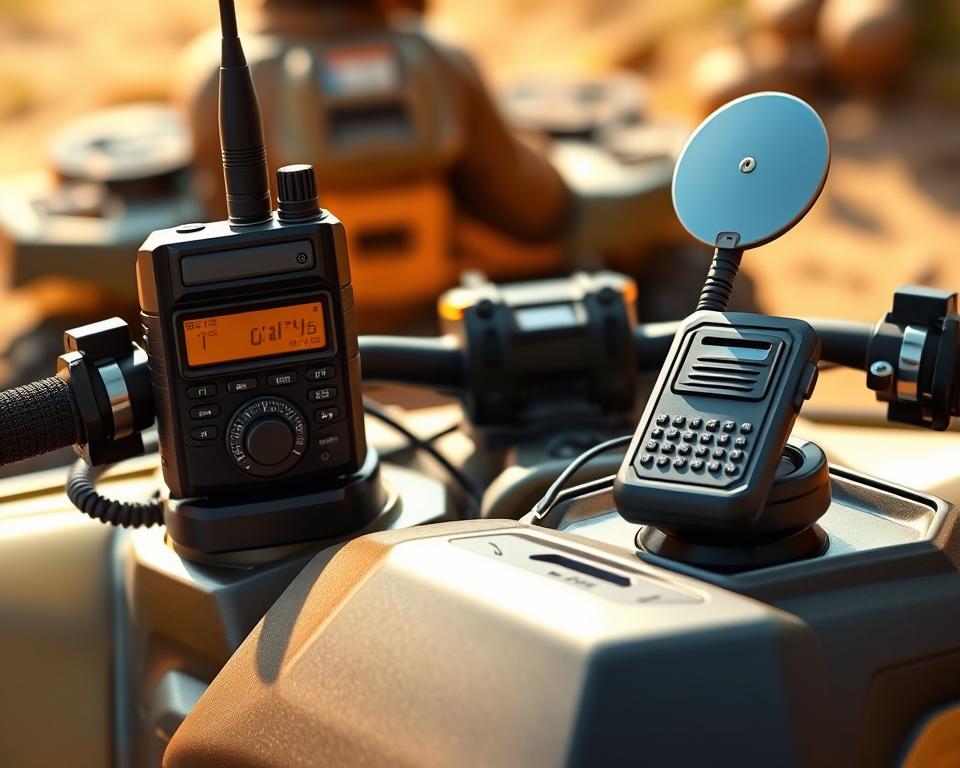Complete ATV Off-Road Safety Prep Guide
Did you realize nearly about 450,000 ATV-related injuries are treated in U.S. emergency rooms each year? This alarming figure highlights the need for safety and preparedness in off-road adventures. Use this Essential ATV Off-Road Checklist to ensure every ride is safe and fun. It covers everything from rocky trails to sand dunes. With the right safety gear and Can Am defender snow plow essentials, you can minimize risks and boost your adventure.
Major Highlights
- Prioritize safety by using the Essential ATV Off-Road Checklist for optimal preparation.
- An ATV safety gear checklist is vital for protecting yourself during off-road rides.
- Regular maintenance is key to keep your ATV in top shape.
- Hydration and nutrition boost endurance and focus on long rides.
- Don’t wander: rely on trusty navigation tools.
- Pack layers and waterproofs for all conditions.
- Always carry essential tools and recovery kits for on-trail repairs and emergencies.
Understanding the Importance of Safety Gear
When you ride off-road, safety must come first. ATVs deliver thrills—and risks. Proper gear guards you against mishaps. Being well-equipped ensures a safer ride and follows an ATV safety gear checklist.

Essential Protective Gear
Maximizing protection involves several key items:
- Helmets: Only DOT-certified lids will protect your skull.
- Eye Protection: Protect your vision with wraparound goggles.
- Riding Gloves: Grip and guard your hands with sturdy gloves.
- Boots: High boots shield your feet and ankles.
- Body Armor: Wear armor to guard your torso on rough trails.
- Neck Protection: Support your neck to prevent serious injury.
Emergency Preparedness
Don’t overlook your emergency kit. An effective emergency kit can be a lifesaver in unexpected situations. Key items to include are:
- First aid kit
- Multi-tool
- Tire repair kits
- Portable air compressors
- Emergency blankets
- Whistles
- Matches
ATV Equipment for Optimal Performance
Gear choices affect how well your ATV runs. Knowing the must-have ATV equipment ensures you’re ready for any journey. Routine checks keep your ATV working its best.
Must-Have ATV Equipment
- Durable Tires: Choose tires that grip mud, sand, and rocks.
- Storage Solutions: Use efficient storage compartments for tools and emergency supplies, ensuring quick access when needed.
- Quality Fuel Tank: Never run low—use a proven fuel tank.
- First Aid Kit: Stock your kit with bandages, antiseptic, and meds.
Regular Maintenance for Longevity
Establishing a consistent maintenance routine is vital. Regular inspections should encompass:
- Checking air filters to keep the engine running smoothly.
- Grease your chain often to avoid skip and wear.
- Inspecting brakes for safety before each ride.
This ATV maintenance checklist is essential for keeping your vehicle in peak condition and ready for adventure.
The Essential ATV Off-Road Checklist
Good prep keeps surprise breakdowns away. An effective ATV maintenance checklist ensures your vehicle’s safety and performance. Cover every item for a worry-free ride. A little prep goes a long way.
Pre-Ride Inspection Basics
Never ride without a quick systems check. This quick evaluation helps riders identify and address issues before they start. Key elements to check include:
- Tire pressure and tread condition
- Fluid levels such as oil and fuel
- Brakes and controls functionality
- Operational lights and horn
- Chain or driveshaft integrity
T-CLOC Inspection Method
Use T-CLOC for a thorough pre-ride check. Tires, Controls, Lights, Oil/Fuel, Chain—don’t miss a spot. This method ensures all critical areas are covered:
| Inspection Area | Checklist Items |
|---|---|
| Tires and Wheels | Check tire pressure, inspect tread depth, look for damage |
| Controls | Test brakes, throttle, and clutch for smooth operation |
| Lights | Ensure headlights, brake lights, and indicators are functioning |
| Oil and Fuel | Check oil level, inspect for leaks, and fill fuel tank |
| Chain/Driveshaft | Examine for wear, proper tension, and lubrication |
Check everything—ride with confidence. Prevent roadside repairs with a fast check.
Hydration and Nutrition for Long Rides
Don’t underestimate water and snacks on extended outings. Riders often underestimate their fluid needs, making it essential to plan ahead. Carry extra water to prevent fatigue and keep energy levels up during the adventure. Nutritious snacks power you through rough stretches.
Importance of Staying Hydrated
Drink often—don’t wait for thirst. It’s important to drink water consistently, not just when thirsty. Backpack reservoirs keep water flowing hands-free.
High-Energy Snacks to Pack
Choosing the right snacks is vital for extended ATV rides. Opt for non-perishable items that are easy to consume. Some ideal choices include:
- Protein bars
- Nut mixes
- Dried fruits
- Beef jerky
Snack smart for sustained energy. Variety prevents taste fatigue and keeps you powered.
Navigation Tools for Off-Roading Adventures
Lose fear of getting lost with the right nav gear. Don’t rely on luck or signals—use real navigation.
Advanced GPS Systems
An advanced GPS system is a must for off-road adventures. Choose units with rugged builds, offline charts, and extended runtime. Garmin, TomTom, and others make GPS units built for bumps and dust.
Traditional Navigation Aids
Technology is key, but traditional tools are also essential. Waterproof maps and compasses are vital backups when your GPS fails. Wind your own way with map and compass skills. Blend modern and classic for ultimate wayfinding.
Communication Equipment for Safety
When phones fail, two-way radios deliver. Using reliable ATV communication gear is vital for safety. Talking to your team prevents misadventures.
For seamless communication among group members, a quality two-way radio is highly recommended. These devices ensure clear audio over long distances. Stay informed of detours or emergencies instantly. When choosing two-way radios, look for models with:
- Rugged, waterproof design to resist the elements
- Long battery life for extended trips without needing a recharge
- Channel selection for clear communication without interference
No ride is complete without radios. Group comms save time and reduce risk. Radios cut through noise and barriers. Clear comms = better rides.
Self-Rescue Gear for ATV Riders
Self-rescue gear is as vital as your helmet. With the right kit, you’ll tackle obstacles solo. Prepared riders make safer group members.
Winches and Recovery Kits
Winches are vital for self-rescue, helping pull your ATV from tough spots. Kit up your winch for maximum extraction muscle. Recovery kits usually include:
- Tow straps
- D-rings
- Recovery boards
- Gloves
Knowledge plus gear equals true self-rescue. With quality ATV recovery kits, you can overcome mud, rocks, or other obstacles and continue your journey.
Trail Recovery Essentials
Your toolbox should extend beyond the winch. These include:
| Equipment | Purpose |
|---|---|
| Recovery Straps | Used for towing or pulling ATVs out of tight situations. |
| Shovel | Helps clear obstacles and dig out vehicles when stuck. |
| Traction Mats | Provides grip under tires in muddy or slick conditions. |
| Portable Air Compressor | Enables quick tire inflation after deflating for better traction. |
Arming your ATV with the right self-rescue gear ensures you can handle any obstacles. Knowing how to use these tools greatly improves safety and adventure on your off-road excursions.
Staying Adaptable: Preparing for Weather Changes
Trail weather can change in minutes. It’s vital to be ready for sudden changes to stay safe and enjoy the ride. Pack for every possible forecast.
Layering your clothes is key to adapting to temperature changes. A dry base keeps you cozy. Fleece or wool gives you warmth on demand. Lastly, have a waterproof and wind-resistant outer shell. Adapt to cold, heat, or storms easily.
Weather-Appropriate Clothing
- Rain Shells: Stay dry when the sky opens up.
- Breathable Pants: Allows for ventilation while protecting against wet conditions.
- Sun Protection: Shield skin from sunburn with proper apparel.
- Insulated Gloves: Keeps hands warm and functional during colder rides.
Quality weather gear is a must for a great off-roading experience. Stay focused on the trail, not on being wet or cold.
Tools for On-Trail Repairs
Essential repair tools are a rider’s best friend. Don’t skimp on repair gear. These tools help address minor breakdowns or issues that may arise during your adventure.
Must-Have Tools and Kits
No ride is complete without a toolkit. A compact kit with everything you need. Critical ATV repair tools might include:
- Tire irons for changing flat tires
- Pliers for gripping and cutting
- Wrenches for various sizes of bolts and nuts
- A multi-tool for versatility
- Spare items such as spark plugs and electrical wire
- Duct tape for quick fixes
Tools at hand mean no surprises.
Basic Emergency Supplies
Tools alone won’t save you—bring these extras. These supplies help ensure your safety in challenging situations:
- First aid kit for injuries
- Flashlight with extra batteries for night-time visibility
- Emergency whistle for signaling assistance
- Reflective triangles or flares to warn other riders
- Water and high-energy snacks for sustenance
Preparedness significantly impacts your off-roading experience. Never leave home without them.
The Final Word
Preparation is the secret to epic trails. Using the Essential ATV off-road checklist and acquiring gear from trusted sources is key. This ensures you’re ready for any terrain.
Gear up fully and ride securely. Effective planning is vital for both safety and performance. Embrace excitement, ditch the doubts.
Stay ready, ride with care, and enjoy the unforgettable moments off-roading offers. The journey is as important as the destination. By following the Essential ATV off-road checklist, you’re set for an incredible adventure in the great outdoors.
FAQ
What should I include in my ATV safety gear checklist?
Include a certified helmet and eye protection. Add gloves, boots, and torso protection. Neck braces offer additional protection. Remember to pack an emergency kit with a first aid kit and multi-tools for preparedness.
How do I keep my ATV in top shape?
Inspect air filters and grease the chain often. Inspect brakes as well. Routine care prolongs longevity and readiness.
What is included in T-CLOC?
T-CLOC inspects five critical systems. Cover Tires, Controls, Lights, Oil/Fuel, Chain in T-CLOC. This ensures your ATV’s critical components are in working order before hitting the trails.
How to gauge water needs off-road?
Overestimate your water needs. Proper hydration wards off exhaustion. Use a hydration bladder for quick sips.
How to stay on course off-road?
Use an off-road GPS unit. Combine this with traditional aids like waterproof maps and compasses.
Why is communication important when off-roading?
Comms keep groups connected and safe. Areas with limited cell service highlight the need for reliable two-way radios.
What self-rescue gear should every ATV rider carry?
Be ready with winch and recovery essentials. This kit should include tow straps, D-rings, and recovery boards.
How to handle trail weather swings?
Layer up and down as conditions shift. Pack a rain shell to stay dry. Wear sun-blocking fabrics and hats.
What tools should I pack for on-trail repairs?
For on-trail repairs, pack a basic tool kit for minor fixes. Don’t forget duct tape and electrical wire.

